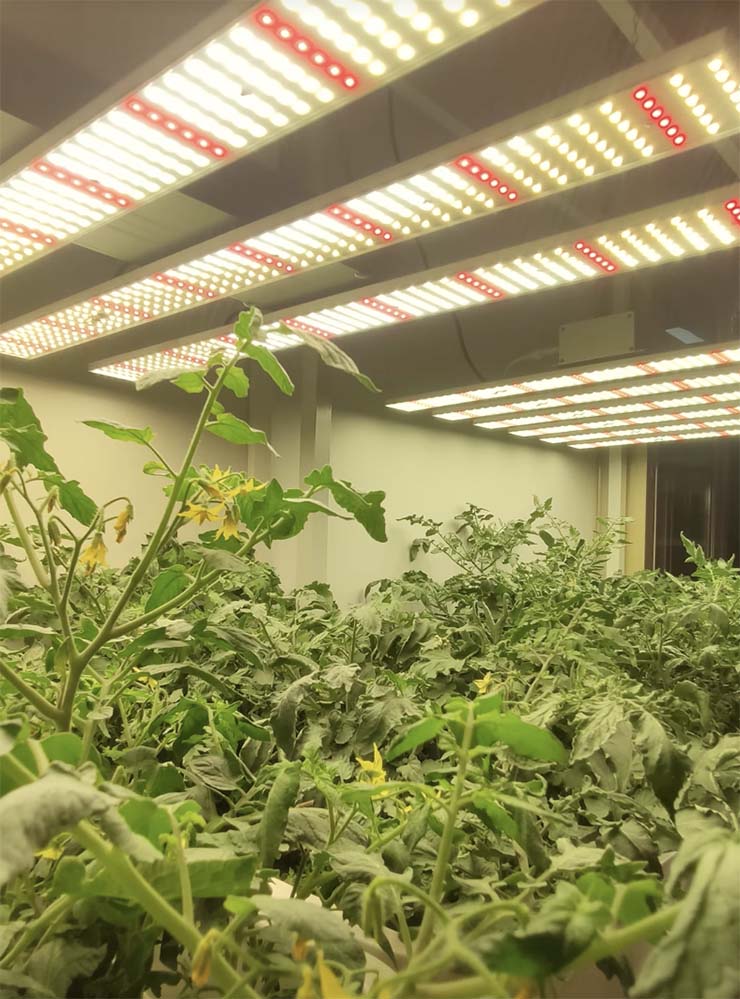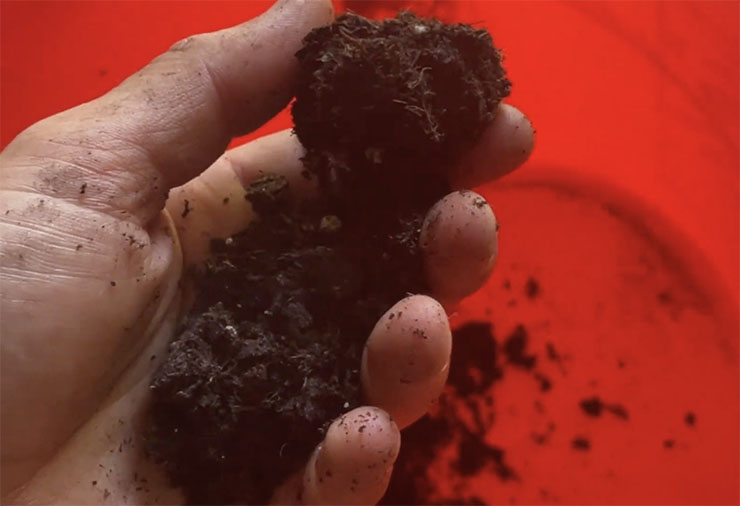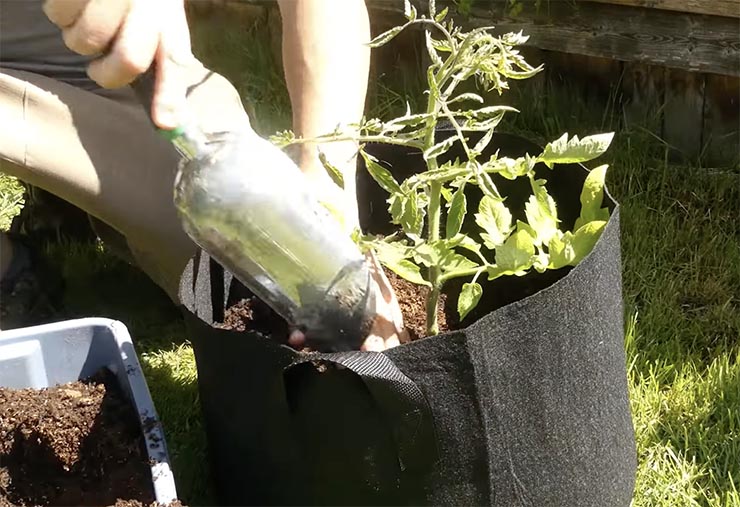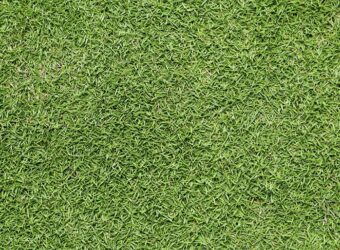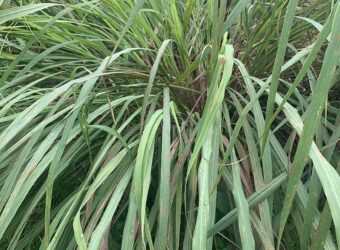More and more people are growing their own vegetables. However, vegetables need to be fertilized, and the many fertilizers available can be confusing. This guide will tell you everything you need to know about fertilizing your vegetable garden.
Why Fertilize Vegetable Gardens?
Vegetables are heavy feeders because it takes a lot to make the vegetables we eat. No garden soil has enough nutrients in it to produce a good crop, so you need to add fertilizer. Every vegetable will grow bigger and better with the proper fertilization.
How Do I Know If My Vegetable Garden Needs Fertilizer?
If the growth is stunted, the leaves are yellow, or the plants have few or no blooms, you need to add fertilizer. Truly, every vegetable requires some fertilization if you want lots of produce.
What Nutrients Do Vegetable Gardens Need?
All plants need sixteen elements to grow. Carbon is derived from the air. Oxygen and hydrogen are derived from water. The other thirteen elements are derived from the soil.
Nitrogen is needed in every cell of the plant. Without nitrogen, a plant cannot grow. Phosphorus is linked to root growth, blooms, and setting fruit. Potassium creates a vigorous plant that can resist diseases. These three nutrients are the ones listed on the front of the fertilizer bag.
Calcium, magnesium, and sulfur are needed in smaller amounts but are still important. Calcium stimulates root and leaf development. It is also important to prevent root rot in tomatoes and other vegetables. Magnesium is part of the chlorophyll molecule. Sulfur is important for protein synthesis.
The remaining nutrients are needed in trace amounts. Boron, copper, iron, manganese, molybdenum, chlorine, and zinc are the trace elements. Boron is needed for cell wall construction. Cooper is present in some enzymes and amino acids. Iron maintains chlorophyll in plants. Manganese activates the plant’s enzymes. Molybdenum is needed for the plant to absorb nitrogen. Zinc is used in some enzymes. Finally, chlorine is needed, but it is not clear what it does because deficiencies in chlorine are really rare.
What Type Of Fertilizer Do Vegetable Gardens Need?
All vegetables need nitrogen to grow. Phosphorus triggers blooms and setting fruit. Potassium builds the plant up and keeps it healthy. Some soils are high in phosphorus and potassium, so people in those areas need to apply nitrogen and not anything else.
A soil test will tell you how much of each nutrient you need to add before planting your vegetables. After that, you need to fertilize to replace the nutrients your vegetables are taking out of the soil during the season. The amount varies by vegetable.
For a little extra money, you can get the amounts of the micronutrients in the soil and recommendations on which you need to add, if any. Soil test instructions are available from your county Extension agent or agricultural advisor.
Do not use acidifying fertilizers for vegetables. They will make the soil too acidic and prevent the plant from using some nutrients.
What Should I Consider When Choosing Fertilizers For My Vegetable Garden?
I consider three factors when choosing fertilizers for my vegetable garden.
Ratio
The first thing I look at is the ratio of nitrogen, phosphorus, and potassium. Balanced fertilizers like 10-10-10 are good if you do not have a soil test or need equal amounts of each nutrient. Triple 12 and triple 13 are sometimes used but tend to be too strong for many vegetables.
Fertilizers such as 3-2-1 are used if you need more of one nutrient than of the others. Some fertilizers have only nitrogen, such as 12-0-0, blood meal. A combination of what you are fertilizing and what nutrients your soil has in it determines what ratio you need in your fertilizer.
Price
Price is a useful way to pick fertilizer. Premium fertilizers are not necessarily more expensive than cheap fertilizers, but they generally have better-quality ingredients in them. These ingredients are generally more bioavailable to your plants than cheaper ingredients.
I always prefer to buy a premium fertilizer for this reason. I avoid cheap fertilizers with sewage sludge (sometimes called sewage solids) in them both for the yuk factor and because there are often heavy metals in the sewage sludge I don’t want on my food.
Buy the best fertilizer you can afford because you are eating the things it fertilizes.
Form
The form is a matter of personal preference.
I prefer liquids for container-grown vegetables and granular fertilizers for raised beds and inground plants. Liquids tend to be available immediately to your plants but usually have to be used every seven to fourteen days.
Many granular formulations have fast-release nitrogen but also have slow-release nitrogen that lasts longer between fertilizations. They are also easier to use if you have a large vegetable garden.
Top 10 Best Fertilizers For Vegetable Gardens
There are lots of fertilizers for vegetable gardens. With my years of experience in growing vegetable gardens. Here are my picks for the ten best.
1. Neptune’s Harvest Organic Hydrolized Fish & Seaweed Fertilizer – Best Liquid Fertilizer For Vegetable Gardens
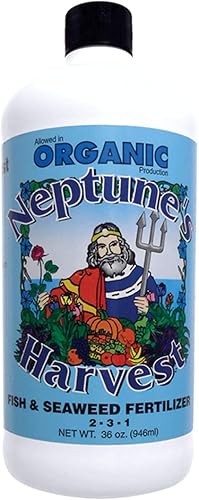
Neptune’s Harvest Organic Hydrolyzed Fish & Seaweed Fertilizer is my pick for the best liquid fertilizer for a vegetable garden.
It has an NPK ratio of 2-3-1 and has a good blend of hydrolyzed fish and seaweed. The gentle fertilizer is perfect for use on seedlings. The concentrate is a bit pricey but fertilizes a lot of plants, so it is worth it.
The website says the product does not have a strong smell, but I think it does straight out of the bottle. The mixed fertilizer does not have a strong smell.
This product is safe for pets and children, although your pet may want to roll in it because of the smell. Neptune’s Harvest Organic Hydrolyzed Fish & Seaweed Fertilizer is certified organic so can be used in organic gardening.
Neptune’s Harvest is a division of Ocean Crest Seafoods Inc. Ocean Crest Seafoods was founded in 1965 by Anthony Parco Sr. to distribute the finest fish from the port of Gloucester. Neptune’s Harvest was founded in 1986 in an effort to use all of the fish after the fillets are removed. When fish are filleted, 70 percent of the fish are left. Neptune’s Harvest cold presses the fish to preserve the vitamins and minerals. They have turned an environmental hazard that used to be thrown into the ocean into an environmental benefit.
To use Neptune’s Harvest Organic Hydrolyzed Fish & Seaweed Fertilizer, first, shake the bottle well to mix the product. Do not mix more solution than you can use in one day. Do not let the product accumulate in the saucer or drip pan because it will concentrate and burn your plants.
For vegetables, mix 1/8th cup in a gallon of water. You can use it to water generously around your plants or use it as a foliar feed. If you use it as a foliar feed, spray it on the top and underside of the leaves until they are wet. Repeat every week.
For container vegetables, mix one tablespoon of fertilizer into one gallon of water. Use in place of water weekly. For seedlings, water with this mixture every two weeks in place of water after the seedlings develop their first true leaves.
When starting seeds, mix one teaspoon of fertilizer into one cup of water. Soak the seeds until they swell. Plant the seeds and water with the soaking liquid.
I use Neptune’s Harvest Organic Hydrolyzed Fish & Seaweed Fertilizer for my seedlings to strengthen them and make them grow better. I prefer granular fertilizer for my outside vegetables because it is easier to use on a lot of plants.
My dog is always very interested when I use this fertilizer so I would be afraid she would roll on my plants if I used it on plants she could reach. This fertilizer is pricey, but I think it is worth it. The gentle formula does not burn my seedlings, and they really respond to the fertilizer.
Pros:
- Organic
- Gentle formula
- Easy to use
Cons:
- Pricey
- Smells strong from the bottle
2. Expert Gardener All-Purpose Water Soluble Plant Food, 24-8-16 Fertilizer – Best Water-Soluble Fertilizer For Vegetable Gardens
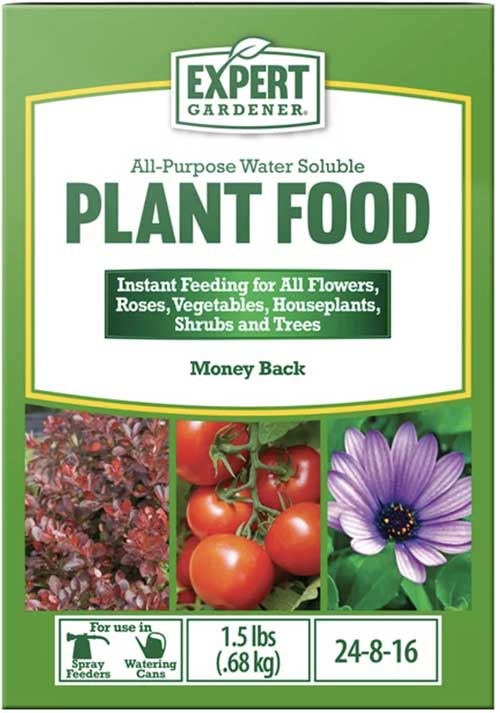
Expert Gardener All-Purpose Water Soluble Plant Food, 24-8-16 Fertilizer is my pick for the best water-soluble fertilizer for vegetable gardens.
The NPK ratio is 24-8-16, and it includes boron, iron, copper, manganese, molybdenum, and zinc. It does not include calcium, sulfur, or magnesium. This fertilizer is specially formulated for use in either hose-end sprayers or watering cans. It dissolves easily and completely into water.
Use Expert Gardener All-Purpose Water Soluble Plant Food, 24-8-16 Fertilizer when you want to feed your plant through both the roots and leaves. It starts working immediately. One box of fertilizer is inexpensive and lasts a long time. This fertilizer is not organic.
The Expert Gardener brand is owned by Walmart. Walmart started as a retailer in Rogers, Ark., and was founded by Sam Walton in 1962. Walmart gradually spread throughout the southern United States. In 1968, Walmart Aviation was founded to fly executives between stores. In 1969, the company became Wal-Mart Stores, Inc. and went public. That same year, Walmart installed an IBM mainframe computer to issue checks from headquarters instead of writing checks at each store. In 1972, Walmart is listed on the New York Stock Exchange. Walmart now operates throughout the United States and in 27 other countries. They have more than 11,500 stores worldwide. It is still controlled by the Walton family.
To use Expert Gardener All-Purpose Water Soluble Plant Food, 24-8-16 Fertilizer, mix one teaspoon of fertilizer in one gallon of water for houseplants and container plants. Repeat every two weeks.
Mix one tablespoon of fertilizer in one gallon of water for outdoor plants in the ground or in raised beds. You can also use this fertilizer in a hose-end sprayer. Repeat every two weeks.
I think Expert Gardener is a good budget brand. I would use this fertilizer on my houseplants because the liquid is easier to use there. If I had container vegetables, I would use this on them, too.
I prefer to use a more premium fertilizer, but if I didn’t have enough money to buy one of those, I would use this one. The box is cardboard and can ruin before the fertilizer is used up. You may have to put the cardboard box in a plastic bag to protect it and the product.
Be careful not to use too much of this fertilizer, or it will burn your plants.
Pros:
- Good budget choice
- Contains trace elements
Cons:
- Not organic
- Can burn plants
3. General Hydroponics Flora Series: FloraMicro, FloraBloom, FloraGro – 3-Part Hydroponic Nutrient System – Best Hydroponic Fertilizer for Vegetable Gardens
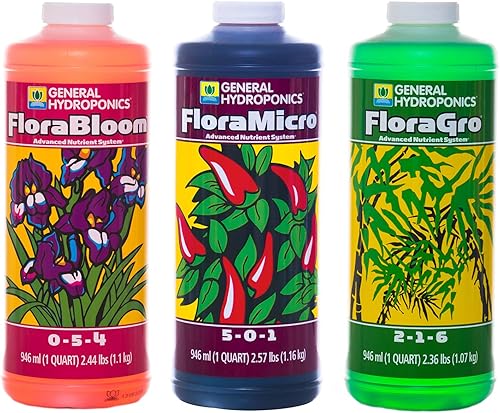
General Hydroponics Flora Series: FloraMicro, FloraBloom, FloraGro – 3-Part Hydroponic Nutrient System is my pick for the best hydroponic fertilizer for vegetable gardens.
This system contains three bottles: FloraMicro, FloraBloom, and FloraGro. FloraMicro contains nitrogen and calcium as well as trace minerals for growth. It has an NPK ratio of 5-0-1. FloraBloom contains phosphorus, potassium, magnesium, and sulfur and has an NPK ratio of 0-5-4. It helps blooms and setting fruit. FloraGro contains additional nitrogen, phosphorus, and potassium. It has an NPK ratio of 2-1-6. It helps structural and foliar growth.
Together, these three products meet all your plant’s needs from seedling to harvest. Because the components are separated, you can customize the nutrient solutions for different stages of growth and different crops. Add to the water according to the chart on the products and watch your plants grow. These products are not organic.
General Hydroponics was founded in 1976 by Lawrence Brooke in a garage in Berkeley, California. in 1994, GH Europe is founded in France by William Texier and Noucetta Kehdi. They grew vegetables for Michelin-starred chiefs in the San Francisco area on their famed White Owl WaterFarm. In 2015, Scotts subsidiary Hawthorne Gardening Co. buys General Hydroponics. Flowr and Hawthorne Canada open the first cannabis research and development lab in 2020 in Canada.
The chart that accompanies the General Hydroponics Flora Series: FloraMicro, FloraBloom, FloraGro – 3-Part Hydroponic Nutrient System bottles provides mixing instructions for several growth stages of vegetable plants.
For seedlings, mix ¼ teaspoon of each product per gallon of water.
For general purpose, mild vegetative growth, mix one teaspoon of each product per gallon of water.
For aggressive vegetative growth, mix three teaspoons of FloraMicro, two teaspoons of FloraBloom, and one teaspoon of FloraGro per gallon of water.
To transition to the bloom stage, mix two teaspoons of each product per gallon of water.
For blooming and ripening, mix one teaspoon of FloraMicro, two teaspoons of FloraBloom, and three teaspoons of FloraGro per gallon of water.
I don’t have a lot of experience with hydroponic systems, but this system makes sense to me. I like that I can customize the nutrient mix according to the growth stages of the plants I am growing.
However, this group of products is not cheap. Three one-quart bottles are expensive. For a large system, they sell much larger containers for a much larger price. Other hydroponic nutrient solutions are expensive, too, of course, and if you are growing a lot of plants, you have to expect to buy your fertilizer to do so.
Pros:
- Customizable for different growth stages
Cons:
- Not organic
- Pricey
4. Jobe’s Organics 09026 Fertilizer – Best Granular Fertilizer for Vegetable Gardens
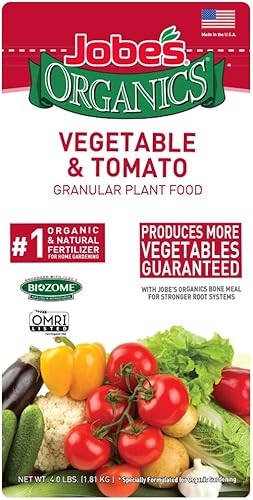
Jobe’s Organics 09026 Fertilizer is my pick for the best granular fertilizer for vegetable gardens.
The NPK ratio is 2-5-3. In addition, the fertilizer contains calcium, magnesium, and sulfur. It also contains Jobe’s special Biozome, a group of soil microbes that break down the nutrients so your plants can use them quickly.
Jobe’s Biozome improves soil conditions to help your garden resist disease, insects, drought, and other unfavorable conditions within a growing season. Jobe’s Organics 09026 Fertilizer will not burn your plants if used as directed. This is a certified organic fertilizer. It is a fairly inexpensive fertilizer, especially for a certified organic fertilizer. Keep this fertilizer away from children and pets.
Jobe’s Company released its first fertilizer in 1969, a tree spike. Easy Gardening bought Jobe’s brand in 1997. Jobe’s Organics was launched in 2007. Centre Lane Partners bought Easy Gardener in 2015. They changed the name of the company to The Jobe’s Company in 2016. The Jobe’s Company makes over 200 fertilizers and other gardening products. These are distributed across North America from the headquarters in Waco, Texas, and additional manufacturing facilities in Kentucky.
Jobe’s Organics 09026 Fertilizer is easy to use. Before planting, mix 1 ½ tablespoons of fertilizer per two-inch plant or 1 ½ cups of fertilizer per ten feet of garden row with the top three inches of soil.
For a container plant, mix 1 ½ tablespoons of fertilizer per four-inch pot or 1 ½ cups per sixteen-inch pot with the potting soil.
For established plants, mix 1 ½ cups of fertilizer into the soil at the dripline per foot of plant spread. Apply every four to six weeks or as needed.
I like organic fertilizer and Jobe’s is a good, reputable company. In addition to some important nutrients, Jobe’s has lots of microbes that will break down nutrients quickly so your plants will grow vigorously.
I do worry that introducing aggressive soil microbes into the soil may cause problems. They may out-compete and kill off the existing soil microbes, causing unknown problems. Soil microbes are important to plants, and they are generally adapted to the microbes in their area.
However, my plants do just fine with the new microbes, so I guess it isn’t too much of a problem. I like that you only have to use it every four to six weeks instead of weekly or every two weeks with liquids. The package may not go far if you have a large garden because of the amount of fertilizer you have to spread.
Pros:
- Organic
- Contains microbes to improve soil
- Good price
Cons:
- Microbes may displace native microbes in the soil
- Not child and pet safe
5. Espoma Organic Garden-Tone 3-4-4 – Best Organic Fertilizer For Vegetable Gardens

Espoma Organic Garden-Tone 3-4-4 Organic Fertilizer for Cool & Warm Season Vegetables and Herbs is my pick for the best organic fertilizer for vegetable gardens.
It has an NPK ratio of 3-4-4. It also has five percent calcium and the exclusive Bio-Tone. This includes Bacillus microbes that improve the soil and make the nutrients in this fertilizer more available to your plants.
It also contains one percent humic acid derived from Leonardite, the best source of humic acid. The whole package not only feeds your plants but improves the soil.
This fertilizer is certified organic. It is made in the United States. Garden-Tone is ready to use and requires no mixing. The fertilizer is slow-release and won’t burn your plants. Espoma Organic Garden-Tone 3-4-4 Organic Fertilizer for Cool & Warm Season Vegetables and Herbs is certified organic.
Herbert G. Sanders founded Espoma in 1929. Espoma was founded in Millville, NJ. After a fire in 1946, Sanders almost didn’t rebuild. His friends and customers cleared the site so he could rebuild, so he did. Espoma was friends with the Holly Society of America’s founders, Clarence Wolf and Daniel Fenton. They could not find a fertilizer for their hollies, so in the late 1940s, Sanders developed one especially for hollies. Realizing other special plants needed fertilizers, Sanders started researching and developing a whole line of specialty fertilizers. Espoma is still owned by the Sanders family and is the leading producer of organic fertilizers for the retail and lawn trade. Produced in the United States, Espoma is available in the United States and Canada.
When using, apply around the dripline of the plants or in a band in the space between rows of plants. For new plantings, apply 3.5 pounds over 50 square feet, then work into the top six inches of soil.
For vegetables, you can apply up to 1/3 cup per plant or put 1 1/3 cup on each side of five feet of row. Repeat monthly.
For new potted plants, mix two cups of fertilizer per cubic foot of potting soil. For established potted plants, spread 1.5 teaspoons of fertilizer per four inches of pot diameter along the outer edge of the soil. Water well.
For herbs in the garden, use one tablespoon of fertilizer per plant. For container herbs, use half the rate for potted plants.
I like Espoma brand fertilizers, and this is a good one to use if you do not have a soil sample. It has enough nitrogen to feed your plant’s growth but not so much that it will cause excessive growth.
I like the fact that it improves the soil as it nurtures my plants. I grow my vegetables organically, so I appreciate having a reputable brand that I can depend on for my organic fertilizer needs.
The fertilizer does come with a premium price, but I think it is worth it.
Pros:
- Organic
- Made in USA
- Good, general fertilizer
- Beneficial microbes
- Conditions soil
Cons:
- Pricey
6. GS Plant Foods Organic Fish and Kelp Blend – Best Fertilizer For Vegetable Gardens In Pots

GS Plant Foods Organic Fish and Kelp Blend is my pick for the best fertilizer for vegetables in pots.
It has an NPK ratio of 2-3-1. Made from fish and kelp, this fertilizer also has trace minerals in it. The formula not only feeds your plants but improves the soil composition. This is a gentle fertilizer that is safe for all your vegetable plants. Mix it at half strength for use on seedlings without burning them.
This fertilizer is certified organic. It is available in larger sizes than this one-quart bottle, including a one-gallon, five-gallon, and fifty-five-gallon drum. Always shake the bottle before using it to mix the concentrate well. This product can be used on more than vegetables, saving you money.
GS Plant Foods is a relatively new company, founded in 2018. The owners are a private family. The founders started the company when they developed a formula for a liquid orchid fertilizer that caused re-blooms on orchids. After many requests for the formula, the founders decided to sell it. After that product was successful, they developed other liquid concentrates for other plants. They are headquartered near Apopka, Florida, and manufacture their products there. Most of their products are certified organic. The owner believes organic products are safer and better for plants than synthetic products.
To use GS Plant Foods Organic Fish and Kelp Blend, mix one tablespoon of fertilizer with one gallon of water. Feed every two to three weeks in place of water.
For a foliar feed, mix two ounces of concentrate in one gallon of water. Spray the upper and lower side of each leaf until it is wet.
Mix two ounces of concentrate in one gallon to use as a fertilizer or foliar feed for outdoor plants.
I prefer liquid fertilizers for container plants because granules can form a hard crust on the surface that blocks water from penetrating the soil if you are not very careful.
I use fish emulsions such as this product to fertilize my seedlings every week from the appearance of the first true leaves until I start to harden them off.
Fish emulsions such as this can have a strong smell. I also only mix as much as I need that day because they don’t keep well.
This fertilizer is a little pricey, but the quart bottle will last quite a while. I also don’t use fish emulsion in self-watering pots as it becomes more concentrated and can burn my plants.
I try to use up a bottle of fish emulsion within about six months of opening so it doesn’t get old.
Pros:
- Acts immediately
- Easy to use
- Organic
- Gentle, won’t burn plants
- Made from renewable ingredients
- Versatile
Cons:
- Strong smell
- Pricey
7. Miracle-Gro Raised Bed Plant Food – Best Raised Bed Fertilizer For Vegetable Gardens

Miracle-Gro Raised Bed Plant Food is my pick for the best raised bed fertilizer for vegetable gardens.
The NPK ratio is 5-1-7. It also includes calcium, magnesium, sulfur, iron, manganese, and zinc. This fertilizer has compost in it that may contain fish and shellfish in it, so wear gloves when you handle this if you are allergic to those things.
Miracle-Gro Raised Bed Plant Food is made especially for raised beds and has enough fertilizer in the bag to feed two 4X4 raised beds for three months. Some of the nitrogen and phosphorus are slow release, while the rest of the nutrients are available immediately.
While most of this fertilizer is synthetic, it does contain some organic material to nourish the soil. This fertilizer is not certified organic.
Miracle-Gro was founded in 1944 by Horace Hagedorn and Otto Stern. Their first product was a fertilizer to strengthen Stern’s plants for shipping. In the 1980s, Hagedorn bought Stern out of the company. In 1995, Hagedorn engineered a merger with Scotts to become Scotts Miracle-Gro. His son was installed as CEO. Scotts was founded by Orlando McLean Scott in Marysville, Ohio in 1868. Scott was a Civil War veteran and wanted to provide clean seeds for farmers. After the turn of the century, he began selling seeds to homeowners. Scotts Miracle-Gro maintains the original storefront in Marysville. Their products are now sold throughout the United States and Canada.
To fertilize a 4X4 foot raised bed, sprinkle half the package evenly over the soil. Mix the fertilizer with the top two to three inches of soil. Water the area well.
If your bed is shaped differently, use 1.5 cups per ten square feet of bed. Repeat every three months during the growing season.
I like that Miracle-Gro Raised Bed Plant Food is developed specifically for raised beds. Miracle-Gro has a large research and development department that tests its products thoroughly before releasing them.
Although not expensive, the package only treats an 8X4 area once. Of course, you only need to apply it once every three months, but having to keep buying small packages can get to be a pain.
It is easy to apply and starts work immediately. You should see the results in about two days in greener plants and faster growth.
I also like that this fertilizer contains some organic material to feed the microbes in the soil as well as synthetic nutrients to feed the plants immediately. Healthy soil is important because plants grow better in it, and many synthetic nutrients do not feed the soil microbes so they starve.
Pros:
- Fast acting
- Has slow-release nitrogen and phosphorus
- Nourishes soil and plants
Cons:
- Small package
- Not organic
8. Down to Earth Blood Meal Fertilizer Mix 12-0-0 – Best Nitrogen Fertilizer For Vegetable Gardens

Down to Earth Blood Meal Fertilizer Mix 12-0-0 is my pick for the best nitrogen fertilizer for vegetable gardens.
The NPK ratio is 12-0-0. Blood meal is a byproduct of the beef industry. The cow’s blood would go to waste but is dried and used as a fertilizer.
In addition, the package this fertilizer comes in is biodegradable. Many vegetables need a shot of nitrogen at some point in their growth, and this is the strongest organic source of nitrogen.
Be sure and follow the label directions as you can burn your plants if you put too much blood meal on them. Keep this fertilizer away from pets as they may try to eat it and get sick. This product is certified organic.
Jack Bates founded Down to Earth in 1977 because he had people asking for organic gardening products and he could not provide them. At one point, he mixed his early fertilizers by rolling 55-gallon drums across the parking lot. Down to Earth has expanded and sells a complete line of natural and organic fertilizers, composts, soil amendments, and potting media. These products work with the microorganisms in the soil so they can break down the nutrients into forms the plants can absorb. Down to Earth uses the best quality ingredients to make premium products that work with nature, not against it. Homeowners, commercial growers, nurseries, and garden centers who want organic products all use Down to Earth products.
For new gardens, apply 2-3 pounds of Down to Earth Blood Meal Fertilizer Mix 12-0-0 over 100 square feet. Mix into the top three inches of soil. Water well to activate the fertilizer.
For existing plants, use 1-2 teaspoons per plant once a month during the growing season. Water in well when done.
For outdoor containers, add 1-2 teaspoons per gallon of soil and mix into the top three inches of soil.
For existing plants, mix one teaspoon of fertilizer per gallon of soil into the top three inches of soil.
I have recommended other Down to Earth products in other articles. Blood meal is all 12-0-0 and is all from the same source. I prefer to use blood meal that is certified organic because I think the extra step means they are more committed to providing a quality product. Down to Earth is a reputable company, as well.
Blood meal will give your plants a boost while they are growing and before they start blooming. I also use it as a general fertilizer because my soil is high in phosphorus and potassium. You may need a fertilizer with phosphorus and potassium in it if your soil does not already have them in it.
Pros:
- Organic
- Gives plants a boost to grow faster and bigger
Cons:
- Can burn plants if over applied
9. Burpee Bone Meal Fertilizer – Best Phosphorus Fertilizer For Vegetable Gardens
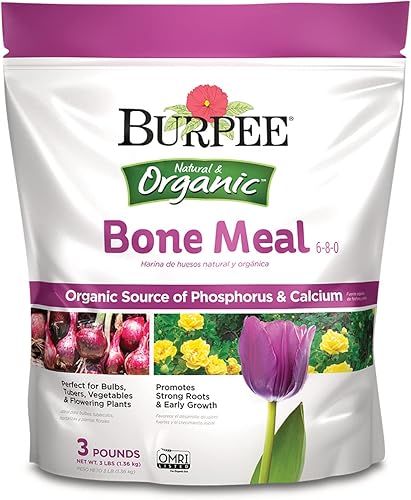
Burpee Bone Meal Fertilizer is my pick for the best phosphorus fertilizer for vegetable gardens.
The NPK ratio is 6-8-0, and it also contains calcium. Phosphorous helps plants develop strong root systems so they are more able to withstand drought and heat.
Bone meal is another byproduct of the cattle industry that would go to waste if not used in fertilizer. Bone meal naturally breaks down slowly to release nitrogen and phosphorous gradually and will not burn your plants.
This product is certified organic.
W. Atlee Burpee founded Burpee in 1876 to carry chickens and livestock. He was 18 and had been a noted expert in breeding chickens since he was 14. He had also just finished medical school. When Burpee’s poultry customers needed a good source of seed to grow to feed their chickens, Burpee obliged. Burpee claims to be the first science-based seed company. Among the many varieties they have bred are iceberg lettuce and Big Boy tomatoes. Since many European-bred seeds didn’t work in America, Burpee set about breeding ones that would flourish here. He sold them through mail-order catalogs since seeds were light and could be easily mailed. George J. Ball, Inc bought the company in 1991 and became the company’s president. Today Burpee grows seeds in the United States, the United Kingdom, Holland, and India. Burpee’s motto is Burpee Seeds Grow. Today they are one of the largest seed companies in the world.
To use Burpee Bone Meal Fertilizer, apply one cup for every twenty square feet of bed. Work into the top two to three inches of soil. Water well.
For container vegetables, use 1 ½ tablespoons of fertilizer per container. Mix in the soil and water well.
Bone meal is another fertilizer where you get the same ingredients no matter where you buy it. Burpee is a very reputable company and has gone through the trouble of having this certified organic.
Some plants need a burst of phosphorous to trigger their blooms. This product also contains a lot of nitrogen to foster plant growth. While this fertilizer will not burn your plants, using too much of it can cause the plant to grow lots of foliage and have few blooms.
In general, I use bone meal for one application per season when my plants are ready to bloom. I do not apply it again during the growing season.
This bone meal is very reasonably priced, especially since you only need to apply it once a season.
Pros:
- Organic
- Apply once a season
- Reasonably priced
Cons:
- May cause overgrowth if you apply too much
10. Dr. Earth Organic 5 Tomato, Vegetable & Herb Fertilizer Poly Bag – Best Overall Fertilizer For Vegetable Gardens

Dr. Earth Organic 5 Tomato, Vegetable & Herb Fertilizer Poly Bag is my pick for the best overall fertilizer for vegetable gardens.
It has an NPK ratio of 4-6-3 and includes calcium, sulfur, magnesium, iron, and manganese. In addition, it contains seven strains of soil microbes and eight select strains of ecto and Endo Mycorrhizae. These organisms make the plants more drought and heat tolerant and the vegetables more nutritious, at least according to Dr. Earth.
The fertilizer also contains six percent humic acid derived from Leonardite. The 100 percent natural and organic formula has both fast-release and slow-release fertilizers. It starts working immediately and lasts for up to three months.
This product contains no GMOs, chicken manure, or sewage sludge. It is certified organic.
Dr. Earth was founded in 1991 by Milo Lou Shammas. The company produced the first probiotic soils and fertilizers in the United States. They pledge that if something is not sustainable or has a positive impact on the environment, they will not do it. This pledge is the reason they use only premium ingredients, never fillers like chicken manure. Dr. Earth uses human food-grade scraps as compost to go into their fertilizers. The products are safe for children and pets. Dr. Earth is the sponsor of the Sustainable Food Trade Association.
The use directions for Dr. Earth Organic 5 Tomato, Vegetable & Herb Fertilizer Poly Bag depend on the vegetables you are growing.
Tomatoes, Peppers, and Herbs
New plantings: Use 1 1/3 cups per ten square feet or 1 ½ cups per twelve feet of row. In a container, use ½ cup per ½ cubic foot (about five gallons). Mix in the soil and water well.
Established plantings: Use one cup per ten square feet or ¾ cup per twelve feet of row. For containers use ¼ cup per five gallons. Mix in the soil and water well.
Repeat the applications every two months.
Eggplant, Cucumber, Corn, Beans, Lettuces, and Broccoli
New plantings: Use 1 ½ cups per ten square feet or two cups per twelve feet of row. For containers, use ½ cup per half cubic foot. Mix in the soil and water well.
Established plantings: Use the same quantities as new plantings.
Repeat applications every other month.
Carrots, Onions, Potatoes, Beets, and Other Root Vegetables
New plantings: Use two cups per twelve feet of row or 1 ½ cups per ten square feet. Mix in the soil and water well.
Established plantings: Use ¾ cups of fertilizer per ten square feet or one cup of fertilizer per twelve feet of row.
Apply every two months, except for carrots. Do not feed carrots mid-season.
I like that this fertilizer is made from food waste, including fish bone meal and fish meal, kelp meal, and supermarket food scraps. Of course, I appreciate the product being certified organic.
I have found my dog is attracted to the fertilizer, but it is not safe for pets to eat, and I don’t want her rolling in my vegetable bed.
I have found this is moderately priced for an organic product.
Pros:
- Food grade ingredients
- Organic
Cons:
- May attract pets
When Do I Fertilize Vegetable Gardens?
When you fertilize your vegetables can be as important as what you use to fertilize. Here are three factors you may have heard about.
Time of Day
It is best to fertilize between dawn and ten a.m. Liquids that splash onto the foliage and stems will have a chance to dry before nightfall. Most granular fertilizers need to be watered in to activate them, so you need to do it in the morning. Plants should not be wet overnight as they are more vulnerable to fungal diseases then.
Stages of Growth
Most vegetables need fertilizer when they are planted in the ground. They then need more fertilizer from when they start blooming until the last vegetable is harvested from them.
If you start seeds indoors, those seedlings need a weak liquid fertilizer from the time they have their first true leaves until they are hardened off. Full-strength fertilizers tend to be too strong for seedlings and risk burning them up.
Time of Year
The time of year is not very reliable for vegetables. They are not like lawns that need fertilizing in early spring and fall. I would pay more attention to growth stages and time of day when fertilizing vegetables.
How Do I Fertilize Vegetable Gardens?
Fertilizing vegetables depends on where you are growing your vegetables.
Vegetable Garden in Pots
For pots, you generally start fertilizing after the fertilizer in the potting mix you use is gone. This is usually after a month. You would use a liquid fertilizer every time or every other time you fertilize. The exact amount varies depending on the brand of fertilizer you choose, but it is usually mixed in a gallon of water and used in place of water for the plant.
In Raised Beds
Before planting vegetables, you generally broadcast the required fertilizer on the area you will be planting your vegetables. Broadcast means spreading the fertilizer evenly over the area. You then scratch the fertilizer in the top three to six inches of soil. Water the fertilizer you have spread to activate it.
After planting, you generally side-dress fertilizer. This is putting a band of fertilizer parallel to the plants and from three to six inches to the side. Water the fertilizer to activate it so your plants can use it.
In the Ground
I fertilize in the ground plants the same way I fertilize raised bed plants.
Hydroponic
Hydroponic systems grow plants in a soilless medium where their roots are periodically washed with water and nutrients. The nutrients are added to the water so must be either a liquid or water-soluble granule. There are special fertilizers for these systems because they must contain everything the plant needs. The exact amounts of the hydroponic fertilizer you need to add depending on the brand of fertilizer.
Signs You Are Over-Fertilizing Your Vegetable Garden
If you have lots of foliage and few blooms, you are giving your garden too much nitrogen. This is the most common mistake I see gardeners make.
A deficiency of nitrogen causes stunted, slow growth and possibly yellow leaves. Yellow leaves can also be caused by a deficiency of iron. A phosphorus deficiency results in a weak, stunted plant. A potassium deficiency can cause yellowing on the margins of leaves, a weak plant, and a poor root system. Beets are sensitive to a boron deficiency, but too much boron kills plants.
Homemade Fertilizer for Vegetable Gardens
If you want to know exactly what is in your fertilizer, you can mix your own. You will need to add nitrogen and possibly phosphorus and potassium, depending on the levels in your soil.
Here are some sources of nitrogen:
- Finely ground eggshells (crushed eggshells won’t help, they must be finely ground)
- Fish emulsion (also called fish fertilizer)
- Composted manure (don’t use uncomposted manure as it carries diseases that can make you sick).
Don’t use coffee grounds. They are too acidic for vegetables.
For phosphorus and potassium, use these components:
- Bone meal
- Fish bone meal
- Seaweed powder
If your soil is deficient in magnesium, you can mix one tablespoon of Epsom salts in a gallon of water and use that to water your plants. Do this once. Too much Epsom salts will kill your plants.
Fertilizers vs. Soil Amendments
A fertilizer is an element that improves the supply of nutrients in the soil, directly affecting plants. A soil amendment improves the soil condition, indirectly affecting plants. A natural fertilizer may also be a soil amendment, such as compost.
Precautions When Applying Fertilizer for Vegetable Garden
Never exceed the recommended amount of fertilizer on the label because you can injure or kill your plants. In addition, never get fertilizer on your plants, as that can burn them.
Vegetable Garden Fertilizing Tips
Here are some tips that can help you when fertilizing your vegetable gardens.
- Always wear gloves when handling granular fertilizers to avoid skin irritation or burns.
- Keep one set of measuring cups dedicated to measuring your fertilizer, and don’t use them for anything else.
- You can harvest vegetables the same day you fertilize as long as you do not get fertilizer on the part you are harvesting.
- Liquid concentrates are more expensive initially but save you money in the long run when measured against ready-to-use mixes.
- To rescue a plant with a nutritional deficiency, use a synthetic fertilizer, as it will work faster.
- To keep plants and soil in good condition, use an organic fertilizer. It works slower, but I think it keeps the soil in better condition, which benefits your plants.
- If your soil is low in boron, apply a solution of one tablespoon of Borax to one gallon of water one time. Too much boron is toxic to plants and people.
- Both organic and synthetic fertilizers can be over-applied and will burn plants.
- Nutrient needs vary between plant families and species.
Caring For Your Vegetable Gardens Throughout Their Lifecycle
Fertilizer isn’t the only thing your vegetable garden needs. Here are some tips for better produce.
- Most vegetables need an inch of water a week. In hot climates, you may need to water twice a week for two inches of water.
- Tomato plants start needing two inches of water a week when they set fruit.
- Never get foliage or fruit wet when watering as it can lead to a fungal disease.
- Put enough compost into your soil for a soil organic matter content of 5-10%. This makes the soil fertile and easy to work.
- Space your plants with the recommended spacing so air can circulate around them. This helps prevent diseases.
- Vegetables need at least six hours of sun a day. Many do better with eight hours of sunlight or more.
- Too much nitrogen can reduce the amount of produce you get and how good it tastes.
- Too much phosphorous will lead to iron chlorosis because the plant will not be able to absorb the iron in the soil.
- Always refrigerate your produce promptly after picking it for the best results. Exceptions are onions, potatoes, and tomatoes, which do better at room temperature.
- Don’t wash your produce until just before you eat it. Washing it earlier can make it spoil faster.
- Vegetables growing in clay soil will need less fertilizer than vegetables grown in sandy soil. Nutrients tend to leach out of the sandy soil when the water drains through it.
- Fertilizers with higher numbers, such as 12-12-12, 13-13-13, or 14-14-14 can be too strong for some plants, especially container vegetables.
- To help remember when to fertilize, I mark the date on my calendar.
- Keep dogs and other animals out of your garden because they may spread zoonotic diseases.
Final Verdict
With so many fertilizers for sale, it was hard to narrow the field to ten fertilizers.
Neptune’s Harvest Organic Hydrolyzed Fish & Seaweed Fertilizer is my pick for the best liquid fertilizer. I use it primarily on my seedlings to give them a good start in life.
I picked Expert Gardener All-Purpose Water Soluble Plant Food, 24-8-16 Fertilizer as the best water-soluble fertilizer. It is a good budget option for a fertilizer.
General Hydroponics Flora Series: FloraMicro, FloraBloom, FloraGro – 3-Part Hydroponic Nutrient System, 1 qt. Bottles is my pick for the best hydroponic fertilizer. I like that you can customize the nutrients you apply to your plants.
The best granular fertilizer goes to Jobe’s Organics 09026 Fertilizer. I like the fact that it is easy to use.
My pick for the best organic fertilizer is Espoma Organic Garden-Tone 3-4-4 Organic Fertilizer for Cool & Warm Season Vegetables and Herbs. I like this brand.
GS Plant Foods Organic Fish and Kelp Blend is my pick for the best fertilizer for container vegetables. I like using a liquid because it is easy to use.
My pick for the best raised bed fertilizer is Miracle-Gro Raised Bed Plant Food. One bag feeds an 8X4 raised bed.
My pick for the best nitrogen fertilizer is Down to Earth Blood Meal Fertilizer Mix 12-0-0. Even the package is biodegradable.
Burpee Bone Meal Fertilizer is my pick for the best phosphorus fertilizer for vegetable gardens. I like that it is certified organic.
My pick for the best overall fertilizer for vegetable gardens is Dr. Earth Organic 5 Tomato, Vegetable & Herb Fertilizer Poly Bag. I like that they upcycle food that would otherwise go to waste.

